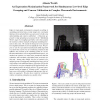Free Online Productivity Tools
i2Speak
i2Symbol
i2OCR
iTex2Img
iWeb2Print
iWeb2Shot
i2Type
iPdf2Split
iPdf2Merge
i2Bopomofo
i2Arabic
i2Style
i2Image
i2PDF
iLatex2Rtf
Sci2ools
CVPR
2004
IEEE
2004
IEEE
Atlanta World: An Expectation Maximization Framework for Simultaneous Low-Level Edge Grouping and Camera Calibration in Complex
Edges in man-made environments, grouped according to vanishing point directions, provide single-view constraints that have been exploited before as a precursor to both scene understanding and camera calibration. A Bayesian approach to edge grouping was proposed in the "Manhattan World" paper by Coughlan and Yuille, where they assume the existence of three mutually orthogonal vanishing directions in the scene. We extend the thread of work spawned by Coughlan and Yuille in several significant ways. We propose to use the expectation maximization (EM) algorithm to perform the search over all continuous parameters that influence the location of the vanishing points in a scene. Because EM behaves well in high-dimensional spaces, our method can optimize over many more parameters than the exhaustive and stochastic algorithms used previously for this task. Among other things, this lets us optimize over multiple groups of orthogonal vanishing directions, each of which induces one addi...
Complex Urban Scenes | Computer Vision | Continuous Parameters | CVPR 2004 | Multiple Orthogonal Edge-groups | Orthogonal Vanishing Directions | Relative Orientation Estimation |
| Added | 12 Oct 2009 |
| Updated | 12 Oct 2009 |
| Type | Conference |
| Year | 2004 |
| Where | CVPR |
| Authors | Grant Schindler, Frank Dellaert |
Comments (0)

